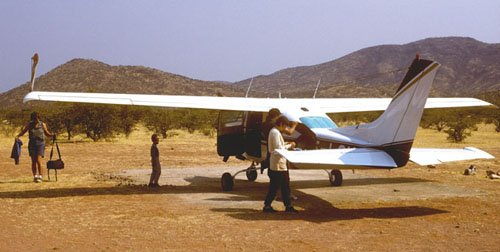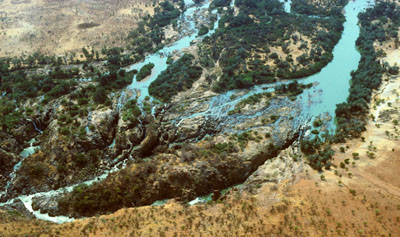
As with most aspects of photography, planning and good preparation is vital when using a light aircraft for aerial photography. The nature of the appropriate preparation is obviously dependent upon the type of flight being undertaken, but the purpose for which the photographs are being taken must be clear and never overlooked.
The picture below shows preparation for a flight over the Epupa River which forms the border between southern Angola and northern Namibia. An aerial image of the river is shown lower down the page.
Flying is expensive so make best use of the available time by planning an optimum route. Mark the proposed route on a map, noting each location that you intend to photograph and how it should be approached. Google Earth is a valuable resource for this planning process, but the details can be taken on the flight on a normal paper road or aeronautical map.
If you do your homework, you should be able to guess during the flight the position of the aircraft from the different spots, and from which side you will shoot. During the flight, keep an eye on motorways, railways, roundabouts, lakes, woods, towns, etc., as they are the best localization marks.
Before setting out on a flight, consider the position of the sun in the sky at various times of the day. Early in the morning and late in the afternoon, when the Sun is low, it may be more difficult to avoid flare. Try to work from the shady side of the aircraft. Aerial sunsets can be spectacular but high contrast can make them difficult to capture.
The landscape can look completely different from season to season. Spring and autumn generally offer colourful vistas in temperate regions of the world, but in tropical and equatorial areas the landscape typically changes with the pattern of the local rains. Winter is landscapes are interesting in hilly or mountainous regions but may otherwise be featureless.

Weather is always relevant when flying, particularly in light aircraft, but it may not be possible to change a pre-arranged flight because the sky has clouded over. Good pictures are still possible under clouded or overcast skies, although shadows are obviously more diffuse and the light levels lower. haze increases with altitude and is almost always present to some extent. It may be difficult to assess the extent to which haze is significant until airborne.
One simple check that often gets forgotten prior to take-off is the cleanliness of the windows. Dirt on the windows can cause unwanted mark, unfocused areas and reflections in images. Check all the windows which may be used for photographic work, both inside and outside. Most windows in light aircraft are made from plexiglass and can be scratched with relative ease. Ask the advice of the pilot and use suitable materials such as a microfibre cloth and some water.






